Study by Optical Spectroscopy of Bismuth Emission in a Nanosecond-Pulsed Discharge Created in Liquid Nitrogen
Abstract
:1. Introduction
2. Materials and Methods
3. Theory
3.1. Optical Model
3.2. Line Broadening
3.3. Line Intensity
3.4. Applied Method
- the basic parameters required in Equation (16)—we, de and a(Te)—to account for Stark broadening (see Table 2). These three parameters are usually set with one spectrum, as the broadening, the position of the maximum and the shape of a given line fully determines the we, de and a(Te);
- the electron density. This variable must decrease in time according to the same law (basically, an exponential decay for a first-order process), whatever the lines;
- the intensity of the continuum emission. This variable must also decrease in time (basically as for a solid body cooling down) and follow the time evolution of the continuum.
4. Results and Discussion
- The agreement between experimental values and the theoretical profiles is very satisfactory. It could be even better by changing the parameters that were set once and for all in the treatment process according to the employed method. Line position, asymmetry, reversal and broadening are well-rendered. Of course, the less satisfying profiles are those where the information is the noisiest, i.e., at short times. It is very clear for the transition at 302.46 nm, where the data before 750 ns could not be modelled (Figure S4d). On the contrary, the intense isolated lines at 289.80, 351.09, 359.61, 412.17 and 472.25 (Figure S4a,e–h) were very well-fitted.
- Minor contributions to a main transition by weak lines (at 307.67 nm for the transition at 306.77 nm (Figure 3), at 340.28 nm and 340.53 nm for the transition at 339.72 nm (Figure 4) and at 299.33 nm for the transition at 298.90 nm (Figure S4c) are needed to describe accurately the whole profile. It is also true for the blue wing of the transition at 293.83 to which the red wing of the transition at 289.80 contributes (Figure S4b), and the red wing of the transition at 302.46 nm to which the blue wing of the transition at 306.67 nm contributes as well (Figure S4d).
- The fact that the transition at 306.77 nm is resonant (Figure 3) makes a double reversal of the line (i.e., a small bump in the hole of the line), which is not observed for the other transitions. Experimentally, this double reversal is not clear but not unlikely anyway (Figure S5). This double reversal comes from the fact that the photons of the continuum are trapped by a lower level implied in a transition where a hole already exists at its central wavelength because the transition is resonant.
- All asymmetric lines have their blue wing expanded, except the one at 351.09 nm whose red wing is expanded—Figure S4e). The singular behaviour of the transition at 351.09 nm is unexplained.
- The accuracy of the profiles of the weak lines at 307.67 nm, 340.28 nm and 340.53 nm is naturally limited, even though their presence improves the profile of the set they form with the intense line they neighbour. It is important here to mention that these lines should spring up even more in the spectrum than they do (e.g., Figure 4) if they were not broadened by the Stark effect.
5. Conclusions
Supplementary Materials
Author Contributions
Funding
Institutional Review Board Statement
Informed Consent Statement
Data Availability Statement
Conflicts of Interest
Sample Availability
References
- Kabbara, H.; Ghanbaja, J.; Noël, C.; Belmonte, T. Nano-objects synthesized from Cu, Ag and Cu28Ag72 electrodes by submerged discharges in liquid nitrogen. Mater. Chem. Phys. 2018, 217, 371–378. [Google Scholar] [CrossRef]
- Kabbara, H.; Ghanbaja, J.; Noël, C.; Belmonte, T. Synthesis of Cu@ZnO core–shell nanoparticles by spark discharges in liquid nitrogen. Nano-Struct. Nano-Objects 2017, 10, 22–29. [Google Scholar] [CrossRef]
- Xing, G.; Jia, S.; Shi, Z. Influence of transverse magnetic field on the formation of carbon nano-materials by arc discharge in liquid. Carbon 2007, 45, 2584–2588. [Google Scholar] [CrossRef]
- Parkansky, N.; Goldstein, O.; Alterkop, B.; Boxman, R.L.; Barkay, Z.; Rosenberg, Y.; Frenkel, G. Features of micro and nano-particles produced by pulsed arc submerged in ethanol. Powder Technol. 2006, 161, 215–219. [Google Scholar] [CrossRef]
- Gang, X.I.N.G.; Jia, S.L.; Shi, Z.Q. The production of carbon nano-materials by arc discharge under water or liquid nitrogen. New Carbon Mater. 2007, 22, 337–341. [Google Scholar]
- Kabbara, H.; Ghanbaja, J.; Noël, C.; Belmonte, T. Synthesis of copper and zinc nanostructures by discharges in liquid nitrogen. Mater. Chem. Phys. 2018, 207, 350–358. [Google Scholar] [CrossRef]
- Kim, S.; Sergiienko, R.; Shibata, E.; Hayasaka, Y.; Nakamura, T. Production of graphite nanosheets by low-current plasma discharge in liquid ethanol. Mater. Trans. 2010, 51, 1455–1459. [Google Scholar] [CrossRef] [Green Version]
- Hamdan, A.; Kabbara, H.; Noel, C.; Ghanbaja, J.; Redjaïmia, A.; Belmonte, T. Synthesis of two-dimensional lead sheets by spark discharge in liquid nitrogen. Particuology 2018, 40, 152–159. [Google Scholar] [CrossRef]
- Qin, F.; Li, G.; Wang, R.; Wu, J.; Sun, H.; Chen, R. Template-free fabrication of Bi2O3 and (BiO)2CO3 nanotubes and their application in water treatment. Chem. A Eur. J. 2012, 18, 16491–16497. [Google Scholar] [CrossRef] [PubMed]
- Morasch, J.; Li, S.; Brötz, J.; Jaegermann, W.; Klein, A. Reactively magnetron sputtered Bi2O3 thin films: Analysis of structure, optoelectronic, interface, and photovoltaic properties. Phys. Status Solidi A 2014, 211, 93–100. [Google Scholar] [CrossRef]
- Tudorache, F.; Petrila, I.; Condurache-Bota, S.; Constantinescu, C.; Praisler, M. Humidity sensors applicative characteristics of granularized and porous Bi2O3 thin films prepared by oxygen plasma-assisted pulsed laser deposition. Superlattices Microstruct. 2015, 77, 276–285. [Google Scholar] [CrossRef]
- Bhande, S.S.; Mane, R.S.; Ghule, A.V.; Han, S.H. A bismuth oxide nanoplate-based carbon dioxide gas sensor. Scr. Mater. 2011, 65, 1081–1084. [Google Scholar] [CrossRef]
- Belmonte, T.; Kabbara, H.; Noël, C.; Pflieger, R. Analysis of Zn I emission lines observed during a spark discharge in liquid nitrogen for zinc nanosheet synthesis. Plasma Sources Sci. Technol. 2018, 27, 074004. [Google Scholar] [CrossRef]
- Li, Z.L.; Bonifaci, N.; Aitken, F.; Denat, A.; von Haeften, K.; Atrazhev, V.M.; Shakhatov, V.A. Spectroscopic investigation of liquid helium excited by a corona discharge: Evidence for bubbles and “red satellites”. Eur. Phys. J. Appl. Phys. 2009, 47, 742–750. [Google Scholar] [CrossRef] [Green Version]
- Pflieger, R.; Ouerhani, T.; Belmonte, T.; Nikitenko, S.I. Use of NH (A3Π–X3Σ−) sonoluminescence for diagnostics of nonequilibrium plasma produced by multibubble cavitation. Phys. Chem. Chem. Phys. 2017, 19, 26272–26279. [Google Scholar] [CrossRef] [PubMed]
- Rond, C.; Desse, J.M.; Fagnon, N.; Aubert, X.; Er, M.; Vega, A.; Duten, X. Time-resolved diagnostics of a pin-to-pin pulsed discharge in water: Pre-breakdown and breakdown analysis. J. Phys. D Appl. Phys. 2018, 51, 335201. [Google Scholar] [CrossRef] [Green Version]
- Miller, M.H.; Bengtson, R.D. Experimental transition probabilities and Stark broadening for singly-ionized bismuth. J. Quant. Spectrosc. Radiat. Transf. 1980, 23, 411–415. [Google Scholar] [CrossRef]
- Dimitrijevic, M.S.; Popovic, L.C. Stark broadening of Bi II lines of astrophysical interest. Astron. Astrophys. Suppl. Ser. 1993, 101, 583–586. [Google Scholar]
- Sahal-Bréchot, S.; Dimitrijević, M.S.; Moreau, N. Observatory of Paris, LERMA and Astronomical Observatory of Belgrade. STARK-B Database. 2021. Available online: http://stark-b.obspm.fr (accessed on 18 July 2021).
- Milosavljević, V.; Poparić, G. Atomic spectral line free parameter deconvolution procedure. Phys. Rev. E 2001, 63, 036404. [Google Scholar] [CrossRef] [PubMed]
- Nikolić, D.; Djurović, S.; Mijatović, Z.; Kobilarov, R. Comment on “Atomic spectral line-free parameter deconvolution procedure”. Phys. Rev. E 2003, 67, 058401. [Google Scholar] [CrossRef]
- Nikolić, D.; Djurović, S.; Mijatović, Z.; Kobilarov, R.; Konjević, N. On modeling of the spectral line shape of heavy neutral nonhydrogen-like emitters. J. Appl. Spectrosc. 2001, 68, 902–910. [Google Scholar] [CrossRef]
- Milosavljević, V.; Ellingboe, A.R.; Djeniže, S. Measured Stark widths and shifts of the neutral argon spectral lines in 4s–4p and 4s–4p′ transitions. Spectrochim. Acta Part B At. Spectrosc. 2006, 61, 81–87. [Google Scholar] [CrossRef] [Green Version]
- Ivković, M.; Zikic, R.; Jovićević, S.; Konjević, N. On simultaneous determination of electron impact width, ion-broadening and ion-dynamic parameter from the shape of plasma broadened non-hydrogenic atom line. J. Phys. B At. Mol. Opt. Phys. 2006, 39, 1773–1785. [Google Scholar] [CrossRef]
- Hamdan, A.; Noel, C.; Kosior, F.; Henrion, G.; Belmonte, T. Impacts created on various materials by micro-discharges in heptane: Influence of the dissipated charge. J. Appl. Phys. 2013, 113, 043301. [Google Scholar] [CrossRef]
- Caiyan, L.; Berzinsh, U.; Zerne, R.; Svanberg, S. Determination of radiative lifetimes of neutral bismuth by time-resolved uv-vuv laser spectroscopy. Phys. Rev. A 1995, 52, 1936–1941. [Google Scholar] [CrossRef] [PubMed] [Green Version]
- Kramida, A.; Ralchenko, Y.; Reader, J.; NIST ASD Team. NIST Atomic Spectra Database (Ver. 5.8); National Institute of Standards and Technology: Gaithersburg, MD, USA, 2021. Available online: https://physics.nist.gov/asd (accessed on 31 July 2021). [CrossRef]
- Belmonte, T.; Noël, C.; Gries, T.; Martin, J.; Henrion, G. Theoretical background of optical emission spectroscopy for analysis of atmospheric pressure plasmas. Plasma Sources Sci. Technol. 2015, 24, 064003. [Google Scholar] [CrossRef]
- Sakka, T.; Nakajima, T.; Ogata, Y.H. Spatial population distribution of laser ablation species determined by self-reversed emission line profile. J. Appl. Phys. 2002, 92, 2296–2303. [Google Scholar] [CrossRef] [Green Version]
- Tortai, J.H.; Bonifaci, N.; Denat, A.; Trassy, C. Diagnostic of the self-healing of metallized polypropylene film by modeling of the broadening emission lines of aluminum emitted by plasma discharge. J. Appl. Phys. 2005, 97, 053304. [Google Scholar] [CrossRef]
- Malvern, A.R.; Pinder, A.C.; Stacey, D.N.; Thompson, R.C. Self-broadening in singlet spectral lines of helium. Proc. R. Soc. Lond. A 1980, 371, 259–278. [Google Scholar]
- Woltz, L.A. Quasi-static ion broadening of isolated spectral lines. J. Quant. Spectrosc. Radiat. Transf. 1986, 36, 547–555. [Google Scholar] [CrossRef]
- Griem, H.R. Plasma Spectroscopy; McGraw-Hill: New York, NY, USA, 1964. [Google Scholar]
- Hamdan, A.; Marinov, I.; Rousseau, A.; Belmonte, T. Time-resolved imaging of nanosecond-pulsed micro-discharges in heptane. J. Phys. D Appl. Phys. 2013, 47, 055203. [Google Scholar] [CrossRef]
- Chung, K.J.; Hwang, Y.S. Thermodynamic properties and electrical conductivity of water plasma. Contrib. Plasma Phys. 2013, 53, 330–335. [Google Scholar] [CrossRef]
- Eubank, P.T.; Patel, M.R.; Barrufet, M.A.; Bozkurt, B. Theoretical models of the electrical discharge machining process. III. The variable mass, cylindrical plasma model. J. Appl. Phys. 1993, 73, 7900–7909. [Google Scholar] [CrossRef]
- Stanek, M.; Musioł, K.; Łabuz, S. Experimental determination of transition probabilities in Bi I and Bi II. Acta Phys. Pol. A 1981, 59, 239–245. [Google Scholar]

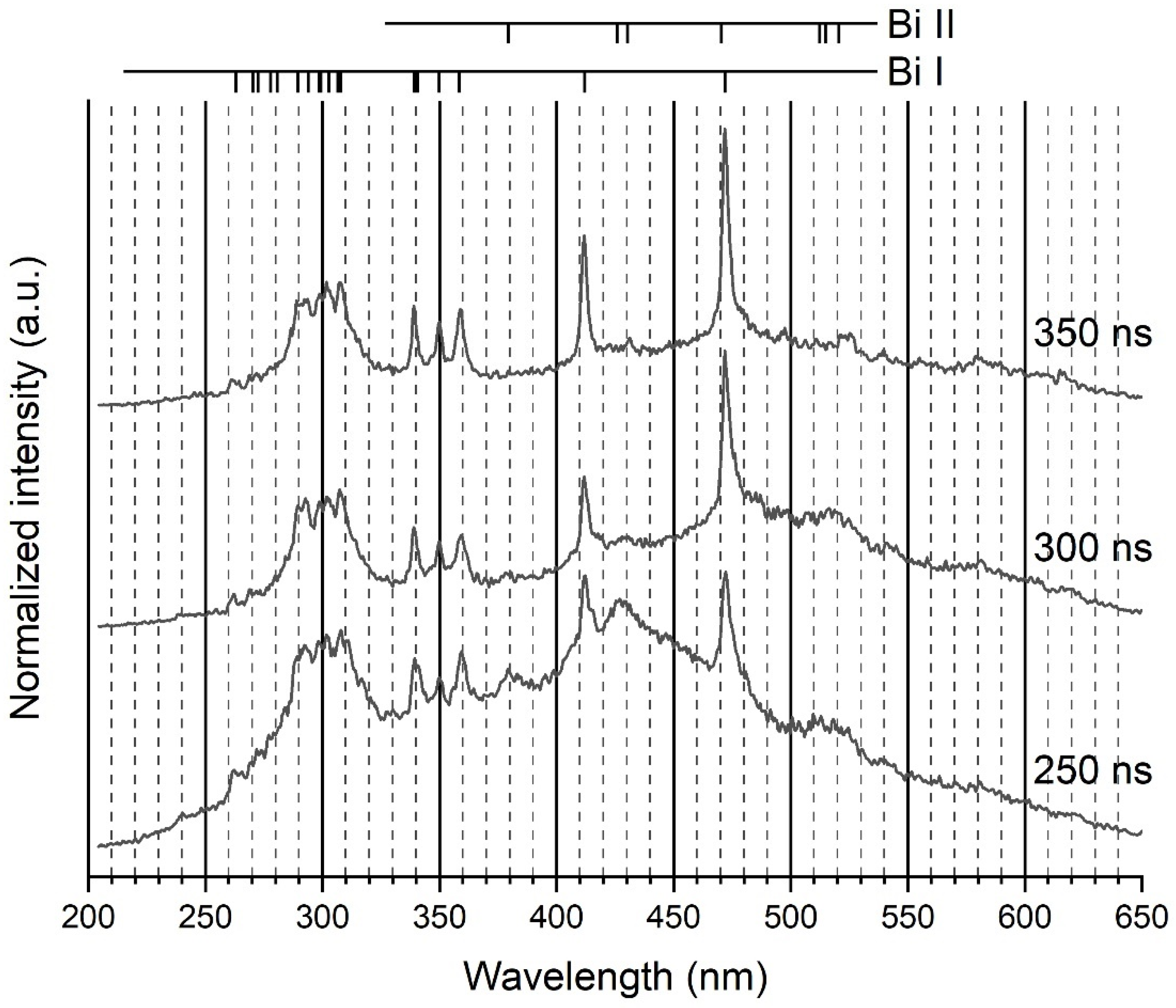
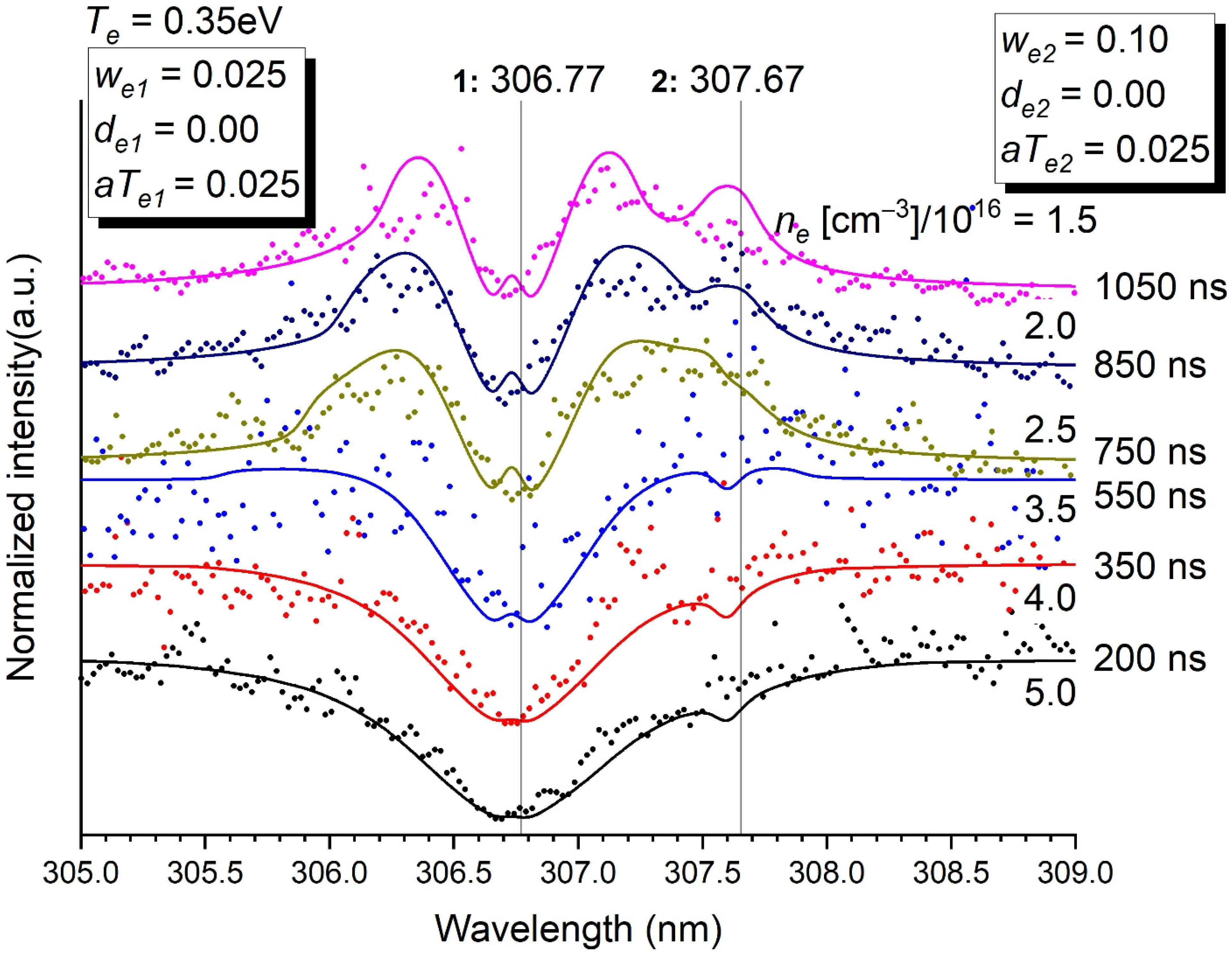
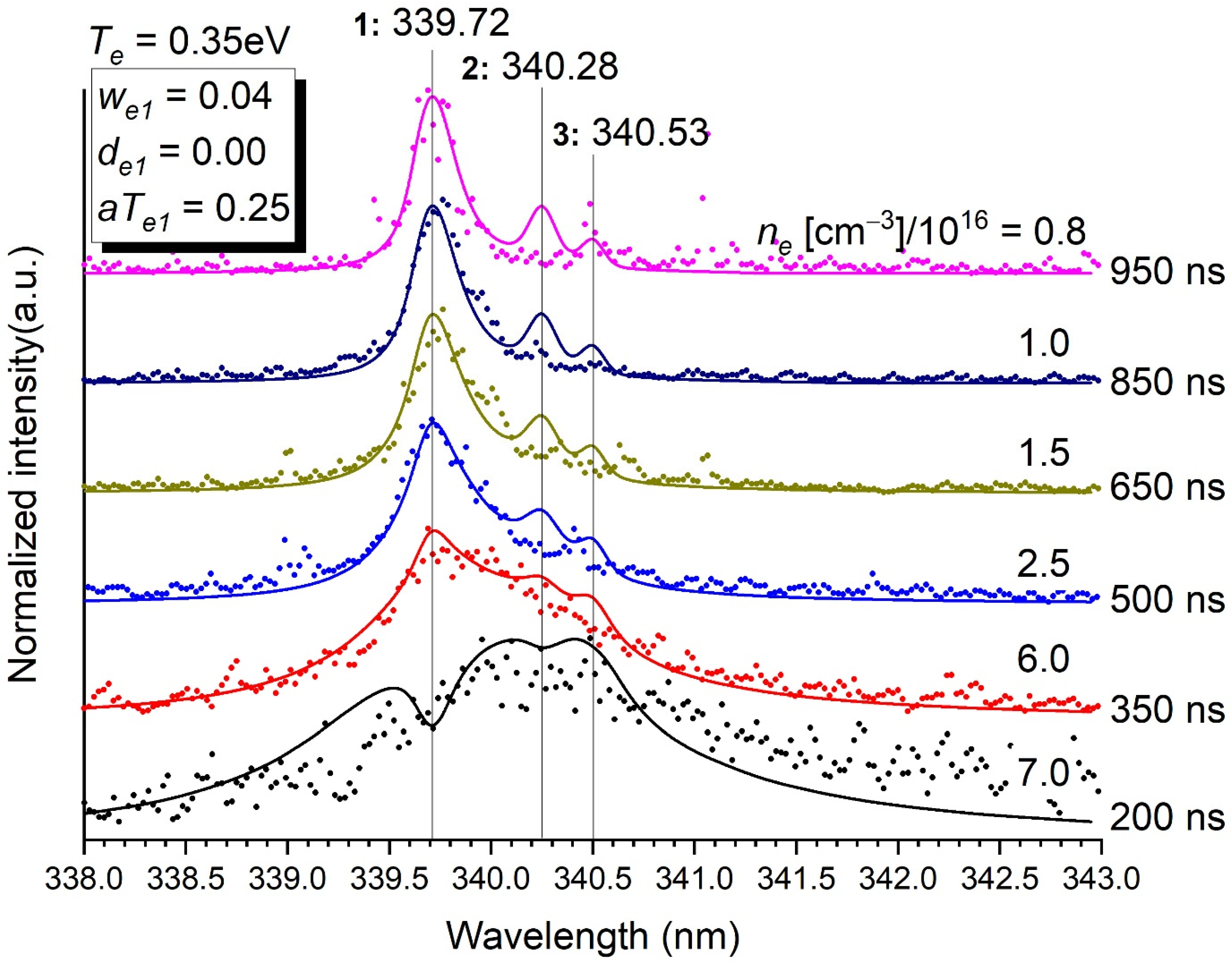

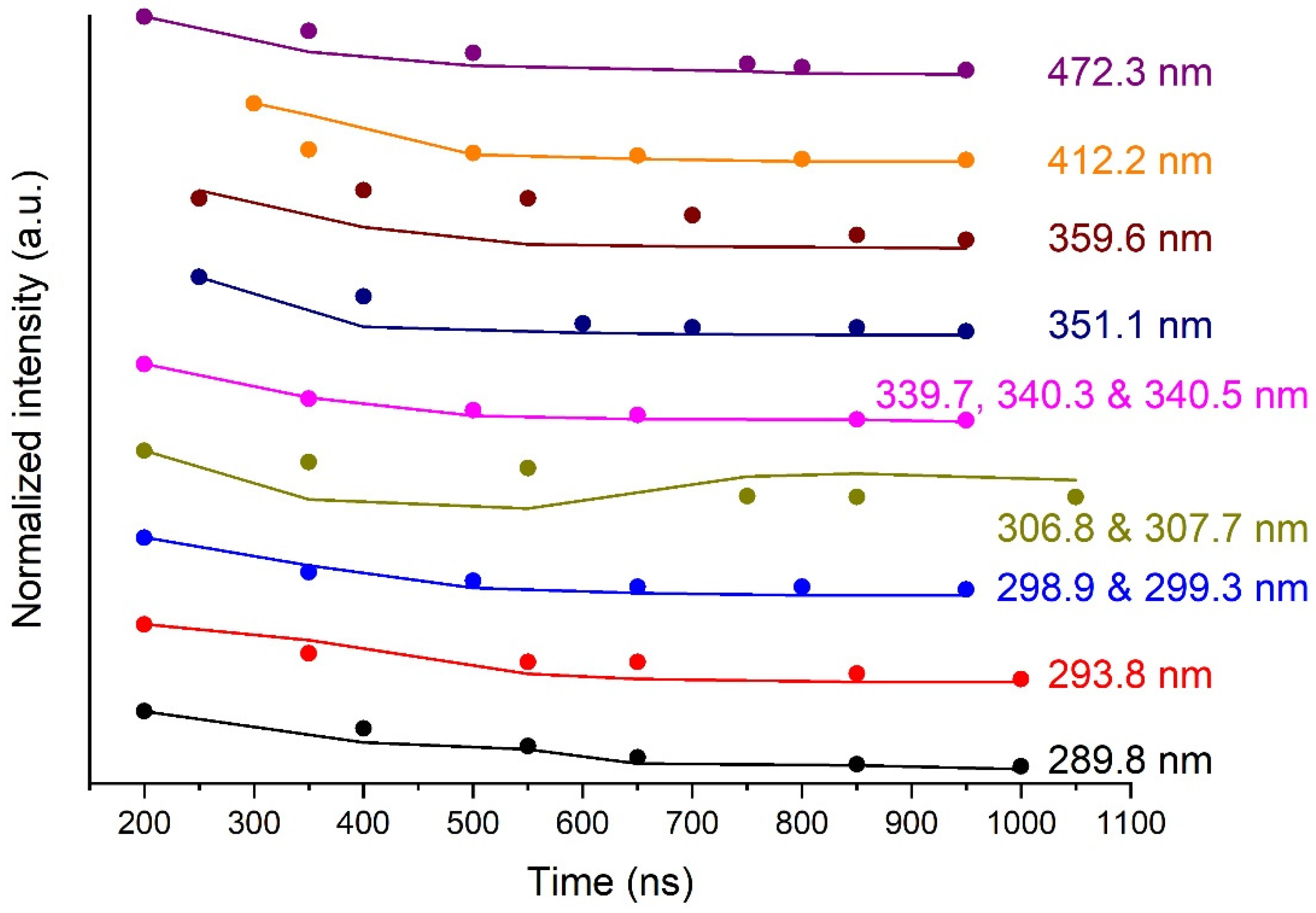
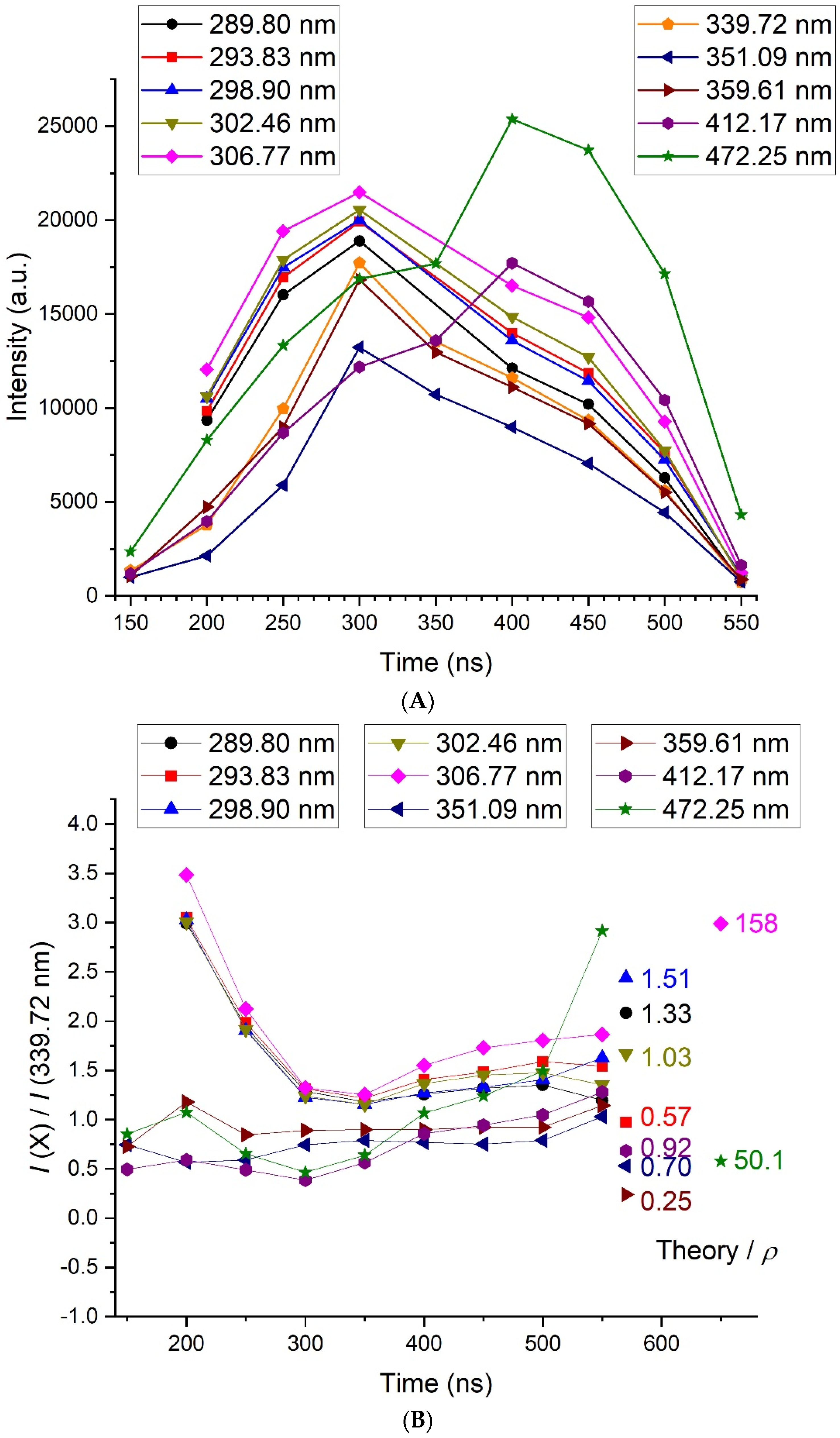
| Wavelength | Rel. Int. | Obs. | Acc. | Aul | Elow | Eup | Jlow | Jup | C’3 | C’6 * | we | de | a(Te) | |
|---|---|---|---|---|---|---|---|---|---|---|---|---|---|---|
| (nm) | (/100) | Int. | (s−1) | (eV) | (eV) | (m3/s) | (m6/s) | (nm) | (nm) | |||||
| Bi I system | 262.7904 | 160 | w | 4.56 × 107 | 1.4157804 | 6.1323713 | 1 | 1 | 1.12 × 10−41 | |||||
| 269.6748 | 50 | vw | 6.20 × 106 | 1.4157804 | 6.0119775 | 1 | 2 | 9.10 × 10−42 | ||||||
| 273.0492 | 17 | vw | 2.02 × 107 | 2.6856111 | 7.2249911 | 0 | 1 | 1.63 × 10−39 | ||||||
| 278.0476 | 50 | vw | 3.09 × 107 | 1.4157804 | 5.8735626 | 1 | 0 | 7.32 × 10−42 | ||||||
| 280.9615 | 25 | vw | 1.34 × 107 | 1.9140062 | 6.3255610 | 2 | 1 | 1.63 × 10−41 | ||||||
| 289.7964 | 410 | s | D+ | 1.53 × 108 | 1.4157804 | 5.6928439 | 1 | 0 | 5.66 × 10−42 | 0.01 | 0.00 | 0.35 | ||
| 293.8297 | 280 | s | D+ | 1.20 × 108 | 1.9140062 | 6.1323713 | 2 | 1 | 1.11 × 10−41 | 0.05 | 0.00 | 0.35 | ||
| 298.9004 | 280 | s | D+ | 5.40 × 107 | 1.4157804 | 5.5625605 | 1 | 1 | 4.69 × 10−42 | 0.01 | 0.00 | 0.025 | ||
| 299.3327 | 60 | s | D+ | 1.45 × 107 | 1.4157804 | 5.5565801 | 1 | 2 | 4.74 × 10−42 | 0.05 | 0.00 | 0.025 | ||
| 302.4618 | 340 | s | D+ | 8.62×107 | 1.9140062 | 6.0119775 | 2 | 2 | 9.02 × 10−42 | 0.025 | 0.00 | 0.40 | ||
| 306.7699 ** | 2300 | s | D+ | 1.67 × 108 | 0 | 4.0404245 | 1 | 0 | 9.72 × 10−15 | 1.18 × 10−42 | 0.025 | 0.00 | 0.025 | |
| 307.6654 | 30 | w | D | 3.31 × 106 | 1.4157804 | 5.4469162 † | 1 | 1 ‡ | 1.02 × 10−42 | 0.1 | 0.00 | 0.025 | ||
| 339.7198 | 70 | s | D+ | 1.79 × 107 | 1.9140062 | 5.5625605 | 2 | 1 | 4.69 × 10−42 | 0.04 | 0.00 | 0.25 | ||
| 340.2800 | 9 | vw | E | 1.50 × 106 | 1.9140062 | 5.5565801 | 2 | 2 | 4.64 × 10−42 | *** | *** | *** | ||
| 340.5330 | 17 | vw | E | 6.40 × 106 | 2.6856111 | 6.3255610 | 0 | 1 | 1.61 × 10−41 | *** | *** | *** | ||
| 351.0864 | 60 | s | D+ | 6.50 × 106 | 1.9140062 | 5.4444405 | 2 | 1 | 4.04 × 10−42 | 0.04 | 0.00 | 0.25 | ||
| 359.6110 | 27 | s | D+ | 1.93 × 107 | 2.6856111 | 6.1323713 | 0 | 1 | 1.09 × 10−41 | 0.05 | 0.00 | 0.20 | ||
| 412.1704 | 26 | s | D+ | 1.64 × 107 | 2.6856111 | 5.6928439 | 0 | 0 | 5.38 × 10−42 | 0.05 | 0.10 | 0.45 | ||
| 472.2528 | 110 | vs | C | 9.40 × 106 | 1.4157804 | 4.0404245 | 1 | 0 | 1.02 × 10−42 | 0.025 | 0.04 | 0.45 | ||
| Bi II system | 379.2564 | 70 | w | 9.8060517 | 13.0742633 | 2 | 3 | |||||||
| 425.9413 | 75 | vw | 10.1985993 | 13.1086088 | 3 | 4 | ||||||||
| 430.1697 | 70 | w | 10.1728579 | 13.0542630 | 2 | 3 | ||||||||
| 470.5285 | 60 | hd | 10.4494435 | 13.0837049 | 1 | 2 | ||||||||
| 512.4356 | 50 | vw | 11.0062562 | 13.425090 | 2 | 3 | ||||||||
| 514.4492 | 60 | vw | 8.5715101 | 10.9808694 | 0 | 1 | ||||||||
| 520.9325 | 75 | vw | 8.6291111 | 11.0084923 | 1 | 2 |
| Wavelength | Instrument | Doppler | vdW IA | vdW QS | Resonance | Stark QS |
|---|---|---|---|---|---|---|
| 289.7964 | 100 | 0.91 | 3.8 | 0.5 | 0 | 159 |
| 293.8297 | 100 | 0.92 | 5.2 | 1.1 | 0 | 794 |
| 298.9004 | 100 | 0.94 | 3.8 | 0.5 | 0 | 123 |
| 299.3327 | 100 | 0.94 | 3.8 | 0.5 | 0 | 614 |
| 302.4618 | 100 | 0.95 | 5.0 | 0.9 | 404 | |
| 306.7699 | 100 | 0.96 | 2.3 | 0.1 | 93.6 | 307 |
| 307.6654 | 100 | 0.97 | 2.2 | 0.1 | 0 | 1228 |
| 339.7198 | 100 | 1.07 | 4.9 | 0.6 | 0 | 591 |
| 340.2800 | 100 | 1.07 | 4.9 | 0.6 | 0 | 368 |
| 340.5330 | 100 | 1.07 | 4.9 | 0.6 | 0 | 123 |
| 351.0864 | 100 | 1.10 | 8.6 | 2.3 | 0 | 591 |
| 359.6110 | 100 | 1.13 | 7.7 | 1.6 | 0 | 711 |
| 412.1704 | 100 | 1.30 | 7.6 | 1.0 | 0 | 850 |
| 472.2528 | 100 | 1.49 | 5.1 | 0.2 | 0 | 425 |
Publisher’s Note: MDPI stays neutral with regard to jurisdictional claims in published maps and institutional affiliations. |
© 2021 by the authors. Licensee MDPI, Basel, Switzerland. This article is an open access article distributed under the terms and conditions of the Creative Commons Attribution (CC BY) license (https://creativecommons.org/licenses/by/4.0/).
Share and Cite
Nominé, A.V.; Noel, C.; Gries, T.; Nominé, A.; Milichko, V.A.; Belmonte, T. Study by Optical Spectroscopy of Bismuth Emission in a Nanosecond-Pulsed Discharge Created in Liquid Nitrogen. Molecules 2021, 26, 7403. https://doi.org/10.3390/molecules26237403
Nominé AV, Noel C, Gries T, Nominé A, Milichko VA, Belmonte T. Study by Optical Spectroscopy of Bismuth Emission in a Nanosecond-Pulsed Discharge Created in Liquid Nitrogen. Molecules. 2021; 26(23):7403. https://doi.org/10.3390/molecules26237403
Chicago/Turabian StyleNominé, Anna V., Cédric Noel, Thomas Gries, Alexandre Nominé, Valentin A. Milichko, and Thierry Belmonte. 2021. "Study by Optical Spectroscopy of Bismuth Emission in a Nanosecond-Pulsed Discharge Created in Liquid Nitrogen" Molecules 26, no. 23: 7403. https://doi.org/10.3390/molecules26237403
APA StyleNominé, A. V., Noel, C., Gries, T., Nominé, A., Milichko, V. A., & Belmonte, T. (2021). Study by Optical Spectroscopy of Bismuth Emission in a Nanosecond-Pulsed Discharge Created in Liquid Nitrogen. Molecules, 26(23), 7403. https://doi.org/10.3390/molecules26237403








